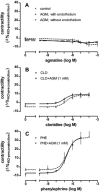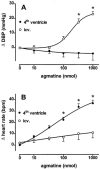Agmatine, an endogenous ligand at imidazoline binding sites, does not antagonize the clonidine-mediated blood pressure reaction
- PMID: 11834614
- PMCID: PMC1573177
- DOI: 10.1038/sj.bjp.0704513
Agmatine, an endogenous ligand at imidazoline binding sites, does not antagonize the clonidine-mediated blood pressure reaction
Abstract
Since agmatine has been identified as a clonidine displacing substance (CDS), the aim of this study was to investigate whether agmatine can mimic CDS-induced cardiovascular reactions in organ bath experiments, pithed spontaneously hypertensive rats (SHR) and anaesthetized SHR. Intravenously-administered agmatine significantly reduced the blood pressure and heart rate of anaesthetized SHR at doses higher than 1 and 3 mg kg(-1), respectively. These effects are probably mediated via central mechanisms, since there was an approximate 8 fold rightward shift of the dose-response curve in the pithed SHR (indicating a weakened cardiovascular effect). Moreover, in organ bath experiments, agmatine failed to alter the contractility of intact or endothelium-denuded aortal rings. When agmatine was administered i.c.v. to anaesthetized SHR, blood pressure was increased without any alteration of heart rate, whereas blood pressure was unchanged and heart rate was increased after injection into the 4th brain ventricle. This suggests that haemodynamic reaction patterns after central application are related to distinct influences on central cardiovascular mechanisms. Agmatine reduces noradrenaline release in pithed SHR while alpha(2)-adrenoceptors are irreversibly blocked with phenoxybenzamine, but not while I(1)-binding sites are selectively blocked with AGN192403. This suggests that agmatine may modulate noradrenaline release in the same way that clonidine does, i.e. via imidazoline binding sites; this involves a reduction in sympathetic tone which in turn reduces blood pressure and heart rate. Finally, CDS-like cardiovascular activity appears not to be due to agmatine, since (i) blood pressure in anaesthetized SHR is decreased by agmatine and clonidine, and (ii) agmatine did not antagonize the blood pressure reaction to clonidine in pithed or anaesthetized SHR.
Figures





Similar articles
-
Evidence that some imidazoline derivatives inhibit peripherally the vasopressor sympathetic outflow in pithed rats.Auton Neurosci. 2008 Dec 5;143(1-2):40-5. doi: 10.1016/j.autneu.2008.07.007. Epub 2008 Sep 6. Auton Neurosci. 2008. PMID: 18774761
-
Central cardiovascular actions of agmatine, a putative clonidine-displacing substance, in conscious rabbits.Neurochem Int. 1997 Jan;30(1):37-45. doi: 10.1016/s0197-0186(96)00044-7. Neurochem Int. 1997. PMID: 9116586
-
Cardiovascular effects of agmatine within the rostral ventrolateral medulla are similar to those of clonidine in anesthetized rats.Exp Brain Res. 2005 Jan;160(4):467-72. doi: 10.1007/s00221-004-2034-7. Epub 2004 Oct 5. Exp Brain Res. 2005. PMID: 15480603
-
Agmatine--a novel endogenous ligand of imidazoline receptors.Pol J Pharmacol. 1997 Mar-Jun;49(2-3):85-8. Pol J Pharmacol. 1997. PMID: 9437754 Review.
-
[Agmatine--an endogenous ligand of imidazoline receptors].Eksp Klin Farmakol. 2003 Sep-Oct;66(5):69-73. Eksp Klin Farmakol. 2003. PMID: 14650220 Review. Russian.
Cited by
-
Pharmacological characteristics of the specific transporter for the endogenous cell growth inhibitor agmatine in six tumor cell lines.Int J Colorectal Dis. 2003 Jul;18(4):314-9. doi: 10.1007/s00384-002-0466-8. Epub 2003 Feb 20. Int J Colorectal Dis. 2003. PMID: 12774246
-
Characterization of imidazoline receptors in blood vessels for the development of antihypertensive agents.Biomed Res Int. 2014;2014:182846. doi: 10.1155/2014/182846. Epub 2014 Apr 3. Biomed Res Int. 2014. PMID: 24800210 Free PMC article.
-
Changes of imidazoline receptors in spontaneously hypertensive rats.Int J Exp Pathol. 2013 Feb;94(1):17-24. doi: 10.1111/iep.12000. Epub 2012 Nov 24. Int J Exp Pathol. 2013. PMID: 23176371 Free PMC article.
-
Biodistribution of Agmatine to Brain and Spinal Cord after Systemic Delivery.J Pharmacol Exp Ther. 2023 Dec;387(3):328-336. doi: 10.1124/jpet.123.001828. Epub 2023 Sep 28. J Pharmacol Exp Ther. 2023. PMID: 37770201 Free PMC article.
-
Agmatine: biological role and therapeutic potentials in morphine analgesia and dependence.AAPS J. 2006 Jul 21;8(3):E479-84. doi: 10.1208/aapsj080356. AAPS J. 2006. PMID: 17025265 Free PMC article. Review.
References
-
- ARMAH B.I. Unique presynaptic alpha 2-receptor selectivity and specificity of the antihypertensive agent moxonidine. Arzneimittelforschung. 1988;38:1435–1442. - PubMed
-
- ATLAS D., BURSTEIN Y. Isolation and partial purification of a clonidine-displacing endogenous brain substance. Eur. J. Biochem. 1984a;144:287–293. - PubMed
-
- ATLAS D., BURSTEIN Y. Isolation of an endogenous clonidine-displacing substance from rat brain. FEBS Lett. 1984b;170:387–390. - PubMed
-
- ATLAS D., DIAMANT S., FALES H.M., PANNELL L. The brain's own clonidine: purification and characterization of endogenous clonidine displacing substance from brain. J. Cardiovasc. Pharmacol. 1987;10 Suppl 12:S122–S127. - PubMed
-
- BERDEU D., PUECH R., LOUBATIERES-MARIANI M.M., BERTRAND G. Agmatine is not a good candidate as endogenous ligand for imidazoline sites of pancreatic B cells and vascular bed. Eur. J. Pharmacol. 1996;308:301–304. - PubMed
Publication types
MeSH terms
Substances
LinkOut - more resources
Full Text Sources
Other Literature Sources

